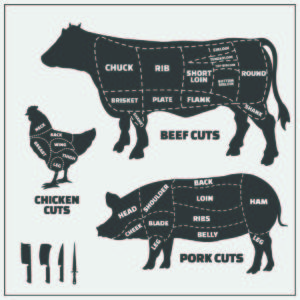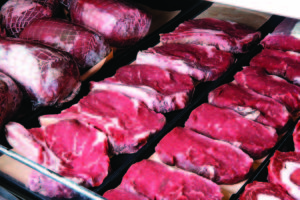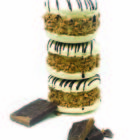Sponsored Content
D’arcy’s Meat market
February, 2018
 A prime above the rest
A prime above the rest
Have you ever bought meat because it was on sale or it was so cheap so you could save money on your next meal, but was disappointed by the poor quality? You’re not alone. Unless you have the knowledge, you may always wonder why this so-called best-cut didn’t live up to expectations. Kyle Iseke, owner of D’Arcy’s Meat Market, wants consumers to be aware of what they’re purchasing when they buy their meat, and why it may make a difference going to a butcher. It all starts with the label.
The label on any beef product is invaluable. It states the grade, price, packaging date, any mechanical tenderizing, any ingredients and its origin. If we’re talking beef, Canadian meat grades are A, AA, AAA and Prime with “Prime” being the highest quality. These grades indicate the beef is from young, healthy animals. The main difference among the grades is the marbling content. The more intramuscular fat present in the cut, the more tender and flavourful the beef—these are your AAA and Prime cuts. So, if the label has an “A” grade or none at all, it’ll be beef almost entirely lacking marbling, flavour and tenderness.
There’s a rising trend at supermarkets for mechanically tenderized and “pumped” meat. Mechanical tenderization is done by the supplier, however, it poses a risk by potentially introducing harmful bacteria into the meat. “And cooking your beef doesn’t kill the bacteria inside if you like your steak medium-rare or rare,” informs Kyle. If the meat has been mechanically tenderized, it has to say so on the label along with safe cooking instructions. Due to this high risk, butchers naturally age their meat instead. As for ingredients—unless it’s sausage, there shouldn’t be an ingredient list.
“If your meat contains anything more than beef, pork or chicken, it’s probably injected or ‘pumped,’” says Kyle. And you’ll know if water-weight has been added when you see “XX% Meat Protein” on the label.
 Country of origin can tell you about what the animal was fed. Alberta is pretty lucky due to its ability to grow top-quality grain and grass. This makes our beef high-quality. Corn- or soy-fed animals may have great fat content, but they’re considered lower quality because these feeds restrict the animal’s ability to process vitamins and minerals properly. Grass- and grain-fed animals remain healthy because their feed allows this nutritional intake, and this is the type of feeding butchers look for when they purchase their products.
Country of origin can tell you about what the animal was fed. Alberta is pretty lucky due to its ability to grow top-quality grain and grass. This makes our beef high-quality. Corn- or soy-fed animals may have great fat content, but they’re considered lower quality because these feeds restrict the animal’s ability to process vitamins and minerals properly. Grass- and grain-fed animals remain healthy because their feed allows this nutritional intake, and this is the type of feeding butchers look for when they purchase their products.
“Consumers have the right to choose what they want to buy, but they should know what they’re buying,” says Kyle.
Labels are your first step in making informed decisions. They’ll tell you whether you’re buying a natural, AAA T-bone steak or an ungraded, soy-protein pumped, corn-fed and mechanically tenderized T-bone. But your best line of defense is asking questions. At a butcher’s shop, the staff are always happy and able to tell you where that cut of meat is from, what grade it is and what the animal was fed.
Choice Cuts
The back muscles of a four-legged animal are considered the best cuts. These include striploin, T-bones, tenderloin, ribeye, with top sirloin a close second. It’s because these muscles are less exercised, which produces soft, tender and highly marbled cuts that enhance the meat’s flavour.












